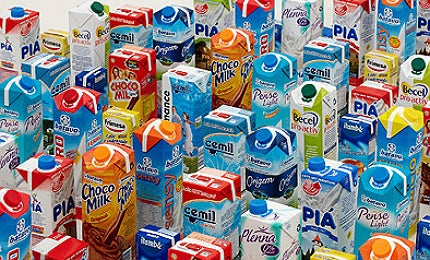Germany-based SIG Combibloc completed the first construction phase at its first packaging plant in Brazil in July 2011. The new plant is located in Campo Largo near Curitiba, in the state of Paraná, and manufactures aseptic carton packs.
SIG is investing €90m ($113m) in the construction of the plant over three phases. The company announced a further investment of more than €36m ($47m) on the project in January 2013.
The entire plant will cover an area of 24,000m². The first phase covered an area of 13,000m² and the second phase increased it to 19,000m². The ongoing third phase will increase the area covered to a total of 24,000m².
The facility currently manufactures about one billion carton packs annually. Capacity will be ramped up to three billion packs a year using six finishing lines, when the latest phase of the project is realised by 2013. An extrusion line is currently being installed as part of the ongoing expansion.
SIG chose Campo Largo for its facility because of its excellent road, ferry and air links and availability of a skilled workforce and logistics services. About 200 people are currently employed at the project site, with an additional 70 people expected to be employed during the coming months.
Single filling machine and carton pack capacities
The plant currently manufactures combiblocStandard, combiblocMidi and combifitMidi carton packs. The combiblocStandard and combiblocMidi packs are available in 500ml, 750ml and 1,000ml capacities.
The facility implements a flexible single filling machine which provides switching options for both combibloc and combifit formats. It uses a very simple process in changing the volume and design of the packs.
The combifit packs are a premium version with a slanted top. The packs are slim and their shape makes them easy to hold. They are available in five formats, with capacities ranging from 150ml to 1,500ml.
SIG produces combibloc packs in nine different base formats. Filling volumes of the packs range from 125ml to 2,000ml. These carton packs are used to fill juices, milk, soups, sauces, tomato products and desserts.
The combibloc cartons are easy to store and transport. They feature a sleeve system, which ensures that no uncoated edges are present to contaminate the product.
The final stage of construction, which is underway, will enable the plant to laminate the unprocessed cardboard for the carton packs, using polymer and aluminum coating. The polymer layer inside the pack will provide a barrier for liquid and the outer layer will enable the pack to prevent moisture. The aluminum layer will protect the packed food from light, oxygen and odour.
Materials and processes at the Brazilian plant
The packaging material used in producing the carton is coated, printed and cut into the desired shape using SIG technology. It is then sealed with a special longitudinal seam to create a flat sleeve. The filling machine seals the base of the sleeves and the interior of the pack is sterilised.
The sterilised product is then filled into the carton pack from the aseptic zone of the machine. Sealing is done ultrasonically above the fill level and not through the product.
The plant converts the carton packs with paper sourced from Scandinavian suppliers. Whole packages will be produced later with paper sourced from local suppliers.
Hygiene at SIG Combibloc’s packaging facility
SIG implements certified quality management systems in accordance with ISO 9001 and environmental management systems in accordance with ISO 14001 at the Parana plant.
In addition, certified hygiene management systems in accordance with the internationally established HACCP principles (hazard analysis and critical control points) have been put in place.
The objective of the hygiene management system is to guarantee that the packaging material and the packaging system are food-safe in line with food legislation, and to ensure a high level of hygiene within the production and storage areas is maintained.
South American market growth
The new SIG Combibloc plant is part of the SIG growth strategy to tap into the South American market.
Demand for carton packs in the region is expected to grow at a rate of eight percent during the next two to three years. With the construction of the new plant, SIG will be able to supply its products to customers in the market.
The South American market is experiencing an increase in demand for milk products, non-carbonated drinks and soya-based drinks. The market will become the second largest in demand for milk products.
Growth of the economy has increased demand for long-life packed food. This, in turn, has increased demand for aseptic carton packs.
The country is the second largest consumer of aseptic carton packs in the world, with a yearly consumption of ten billion packs.
Related content
Alcoa Aluminio Carton Packaging Recycling Plant, Brazil
Alcoa Aluminio, in a joint venture with Tetra Pak, Klabin and TSL Ambiental, launched its new recycling plant in Brazil in May 2005.
Papier-Mettler Plastics Recycling Plant, Morbach, Germany
Papier-Mettler’s new plastics recycling plant is located in the Hunsrück mountain region of Morbach in Germany.










